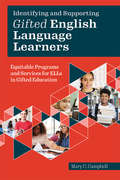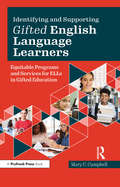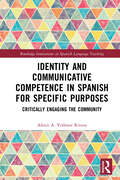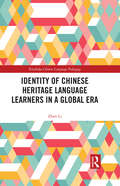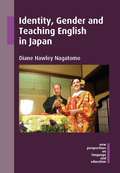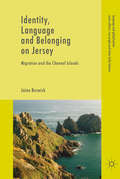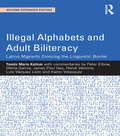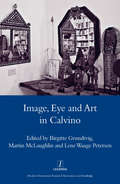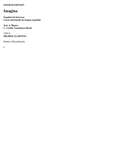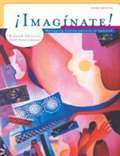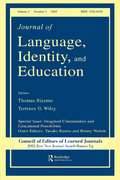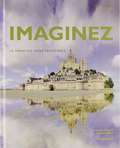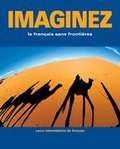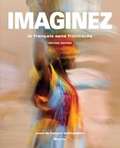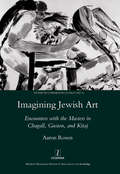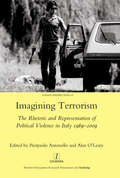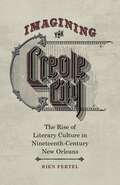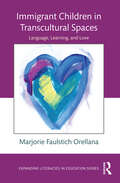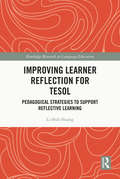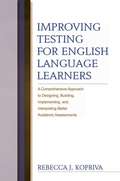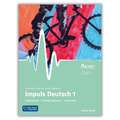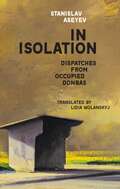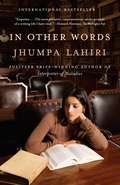- Table View
- List View
Identifying and Supporting Gifted English Language Learners: Equitable Programs and Services for ELLs in Gifted Education
by Mary CampbellThis book is a practical guide for identifying and supporting gifted English language learners (ELLs) based on research and firsthand teaching experience. This book:Presents practical information and strategies for identifying gifted ELLs.Helps readers understand more about potentially gifted behaviors and talents.Supports the enrichment and social-emotional needs of these students.Includes background information, teaching strategies, and methods.Offers ideas for lessons and activities that can be used to support any learner.Research from the last 2 decades shows that there is a considerable disparity between ELLs and native English speakers identified as gifted. This book will inspire action by key players in these students' lives, including English language and gifted educators, classroom teachers, school administrators, district and state leaders, families, and the greater community.
Identifying and Supporting Gifted English Language Learners: Equitable Programs and Services for ELLs in Gifted Education
by Mary Catharine CampbellThis book is a practical guide for identifying and supporting gifted English language learners (ELLs) based on research and firsthand teaching experience. This book:Presents practical information and strategies for identifying gifted ELLs.Helps readers understand more about potentially gifted behaviors and talents.Supports the enrichment and social-emotional needs of these students.Includes background information, teaching strategies, and methods.Offers ideas for lessons and activities that can be used to support any learner.Research from the last 2 decades shows that there is a considerable disparity between ELLs and native English speakers identified as gifted. This book will inspire action by key players in these students' lives, including English language and gifted educators, classroom teachers, school administrators, district and state leaders, families, and the greater community.
Identity and Communicative Competence in Spanish for Specific Purposes: Critically Engaging the Community (Routledge Innovations in Spanish Language Teaching)
by Alexis A. Vollmer RiveraIdentity and Communicative Competence in Spanish for Specific Purposes analyzes the experiences of three Spanish for specific purposes (SSP) students, offering insight into the intersectionality of society, politics, identity, and linguistics in community-based settings.Analyses provide empirical evidence to a growing body of work about how experiential language learning (EX-LL) enhances student preparation to utilize target languages in professional services. Ethnographic portraits and discourse analysis also illustrate how EX-LL, such as internships, provides students with opportunities to position and protect their identities using linguistic and extralinguistic resources. Discussions are presented throughout the volume on how to implement EX-LL from a critical perspective that supports students while mutually benefiting community members. Harnessing community members’ stories to contextualise and illustrate the disparities U.S. Hispanic/Latinx communities face in accessing high-quality care and services, the volume proposes SSP as a form of advocacy to narrow this gap while simultaneously enhancing students’ skills in Spanish.Designed for graduate students, educators, researchers, and program developers in SSP, second language acquisition, heritage language pedagogy, and sociolinguistics, this volume will prompt the reader to (re)imagine how language learning traverses society, politics, and identity in community-based settings.
Identity of Chinese Heritage Language Learners in a Global Era (Routledge Chinese Language Pedagogy)
by Zhen LiIdentity of Chinese Heritage Language Learners in a Global Era enriches the current research on heritage language (HL) learner identity by examining how identity is constructed, negotiated, and performed in the narratives of university Chinese HL (CHL) learners in Hong Kong. This monograph has identified three sub-categories of CHL learners: domestic-born Chinese, ‘third culture’ Chinese, and overseas Chinese sojourners. Through systematically examining these CHL learners’ life-history narratives about language learning, language use, and social experiences from early childhood to university time, this monograph shows how CHL learner identity is dynamically constructed and changed through self and social positioning across a wide range of spatio-temporal contexts. It also adopts investment, agency, and imagined communities to examine the shared discourses which reflect the relationship between identity and the larger social processes that involve transnational or postcolonial encounters. This monograph contributes to reflections on the emerging discourses of HL learner identity in the context of multilingualism and transnational migration. It challenges the stigmatised image of CHL learners as ‘diasporic subjects’ or ‘language minority students’ in the literature and conceptualises CHL learners as transformative linguistic and social actors in processes of transnational migration and institutional change. This monograph is targeted toward educators, researchers, and professionals working in the fields of heritage language, overseas Chinese studies, migrant studies, and intercultural studies.
Identity, Gender and Teaching English in Japan
by Diane Hawley NagatomoHow do teachers who have chosen to settle down in one country manage the difficulties of living and teaching English in that country? How do they develop and sustain their careers, and what factors shape their identity? This book answers these questions by investigating the personal and professional identity development of ten Western women who teach English in various educational contexts in Japan, all of whom have Japanese spouses. The book covers issues of interracial relationships, expatriation, equality and employment practices as well as the broader topics of gender and identity. The book also provides a useful overview of English language teaching and learning in Japan.
Identity, Language and Belonging on Jersey: Migration and the Channel Islands (Language and Globalization)
by Jaine BeswickThis book examines transnational identities, integration and linguistic practices on Jersey, one of the Channel Islands. Within the context of major historical events and migratory flows, the author considers the significance of the multicultural small island space, ideologies regarding long-standing as well as emergent identification practices and language use, and conceptualizations of belonging, focusing in particular on the Madeiran Portuguese diaspora. The juxtaposition of historical and contemporary migratory flows opens up a compelling discussion concerning the maintenance and use of heritage languages in a multilingual environment, allowing a rare comparison of the symbolic role as ethnic identifiers of Jersey French, Standard French, English, and more contemporary migrant languages such as Portuguese. The author analyses the role of language in social integration and the potential for consequent shifts in group allegiances, as well as receptor community ideological and legislative responses, concluding with a hypothesised look at the future of migration to Jersey. This book advances research on migration, transnational lives and language use in an era of globalization, and will be of particular interest to students and scholars in the fields of sociolinguistics, multilingualism, migration studies, and intercultural communication.
Illegal Alphabets and Adult Biliteracy: Latino Migrants Crossing the Linguistic Border, Expanded Edition
by Tomás Mario KalmarHow do "illegal aliens" chart the speech sounds of colloquial English? This book is timeless in offering an unusually direct entry into how a group of Mexican fruit pickers analyze their first encounter with local American speech in a tiny rural Midwestern community in the United States. Readers see close up how intelligently migrant workers help each other use what they already know—the alphabetic principle of one letter, one sound—to teach each other, from scratch, at the very first contact, a language which none of them can speak. They see how and why the strategies adult immigrants actually use in order to cope with English in the real world seem to have little in common with those used in publicly funded bilingual and ESL classrooms. What’s new in this expanded edition of Tomás Mario Kalmar’s landmark Illegal Alphabets and Adult Biliteracy are in-depth commentaries from six distinguished scholars—Peter Elbow, Ofelia García, James Paul Gee, Hervé Varenne, Luis Vázquez León, Karen Velasquez—who bring to it their own personal, professional, and (multi)disciplinary viewpoints.
Image, Eye and Art in Calvino
by Birgitte GrundtvigFew recent writers have been as interested in the cross-over between texts and visual art as Italo Calvino (1923-85). Involved for most of his life in the publishing industry, he took as much interest in the visual as in the textual aspects of his own and other writers' books. In this volume twenty international Calvino experts, including Barenghi, Battistini, Belpoliti, Hofstadter, Ricci, Scarpa and others, consider the many facets of the interplay between the visual and textual in Calvinos works, from the use of colours in his fiction to the influence of cartoons, from the graphic qualities of the book covers themselves to the significance of photography and landscape in his fiction and non-fiction. The volume is appropriately illustrated with images evoked by Calvino's major texts.
Imagina
by José A. Blanco C. Cecilia Tocaimaza-HatchImagina, 4th Edition, Looseleaf Student Edition
Imagina
by José A. BlancoIMAGINA, an exciting intermediate Spanish program designed to provide you with an active and rewarding learning experience as you continue to strengthen your language skills and develop cultural competency.
Imagina: Español sin barreras, Curso intermedio de lengua española
by José A. Blanco C. Cecilia Tocaimaza-Hatch Próspero N. GarcíaNIMAC-sourced textbook
Imaginate! Managing Conversations in Spanish (3rd Edition)
by Kenneth Chastain Gail GuntermannIMAGÍNATE! moves students from "textbook" Spanish to more authentic, natural, and flowing speech with practical conversational strategies and useful expressions.
Imagined Communities and Educational Possibilities: A Special Issue of the journal of Language, Identity, and Education
by Thomas Ricento Terrence G. WileyImagined Communities and Educational Possibilities focuses on three main themes: imaged communities expand the range of possible selves, technological advances in the last two decades have had a significant impact on what is possible to imagine, and imagination at even the most personal level is related to social ideologies and hegemonies. The diverse studies in this issue demonstrate convincingly that learners and teachers are capable of imagining the world as different from prevailing realities. Moreover, time and energy can be invested to strive for the realization of alternative visions of the future. Research in this special issue suggests that investment in such imagined communities offers intriguing possibilities for social and educational change.
Imaginez: Le français sans frontières, Cours de français intermédiaire
by Séverine ChampenyNIMAC-sourced textbook <P><P>Intermediate Course in French
Imaginez: le français sans frontières, cours de français intermédiaire
by Cherie MitschkeVista Higher Learning is proud to announce the publication of IMAGINEZ: Le français sans frontiers. This textbook program provides a smooth transition between first-year and second-year French texts. IMAGINEZ is designed to engage students actively as they build their language skills and broaden their understanding of the diverse cultures of the francophone world.
Imaginez: le français sans frontières, cours de français intermédiaire
by Cherie MitschkeNIMAC-sourced textbook
Imagining Jewish Art: Encounters with the Masters in Chagall, Guston, and Kitaj
by Aaron RosenShort-listed for the Art and Christian Enquiry/Mercers' International Book Award 2009: 'a book which makes an outstanding contribution to the dialogue between religious faith and the visual arts'. What does modern Jewish art look like? Where many scholars, critics, and curators have gone searching for the essence of Jewish art in Biblical illustrations and other traditional subjects, Rosen sets out to discover Jewishness in unlikely places. How, he asks, have modern Jewish painters explored their Jewish identity using an artistic past which is- by and large - non-Jewish? In this new book we encounter some of the great works of Western art history through Jewish eyes. We see Matthias Grunewald's Isenheim Altarpiece re-imagined by Marc Chagall (1887-1985), traces of Paolo Uccello and Piero della Francesca in Philip Guston (1913-1980), and images by Diego Velazquez and Paul Cezanne studiously reworked by R.B. Kitaj (1932-2007). This highly comparative study draws on theological, philosophical and literary sources from Franz Rosenzweig to Franz Kafka and Philip Roth. Rosen deepens our understanding not only of Chagall, Guston, and Kitaj but also of how art might serve as a key resource for rethinking such fundamental Jewish concepts as family, tradition, and homeland.
Imagining Terrorism: The Rhetoric and Representation of Political Violence in Italy 1969-2009
by Pierpaolo AntonelloNo other European country experienced the disruption of political and everyday life suffered by Italy in the so-called 'years of lead' (1969-c.1983), when there were more than 12,000 incidents of terrorist violence. This experience affected all aspects of Italian cultural life, shaping political, judicial and everyday language as well as artistic representation of every kind. In this innovative and broad-ranging study, experts from the fields of philosophy, history, media, law, cinema, theatre and literary studies trace how the experience and legacies of terrorism have determined the form and content of Italian cultural production and shaped the country's way of thinking about such events?
Imagining the Creole City: The Rise of Literary Culture in Nineteenth-Century New Orleans
by Rien FertelIn the early years of the nineteenth century, the burgeoning cultural pride of white Creoles in New Orleans intersected with America's golden age of print, to explosive effect. Imagining the Creole City reveals the profusion of literary output -- histories and novels, poetry and plays -- that white Creoles used to imagine themselves as a unified community of writers and readers.Rien Fertel argues that Charles Gayarré's English-language histories of Louisiana, which emphasized the state's dual connection to America and to France, provided the foundation of a white Creole print culture predicated on Louisiana's exceptionalism. The writings of authors like Grace King, Adrien Rouquette, and Alfred Mercier consciously fostered an image of Louisiana as a particular social space, and of themselves as the true inheritors of its history and culture. In turn, the forging of this white Creole identity created a close-knit community of cosmopolitan Creole elites, who reviewed each other's books, attended the same salons, crusaded against the popular fiction of George Washington Cable, and worked together to preserve the French language in local and state governmental institutions. Together they reimagined the definition of "Creole" and used it as a marker of status and power.By the end of this group's era of cultural prominence, Creole exceptionalism had become a cornerstone in the myth of Louisiana in general and of New Orleans in particular. In defining themselves, the authors in the white Creole print community also fashioned a literary identity that resonates even today.
Immigrant Children in Transcultural Spaces: Language, Learning, and Love (Expanding Literacies in Education)
by Marjorie Faulstich OrellanaGrounded in both theory and practice, with implications for both, this book is about children’s perspectives on the borders that society erects, and their actual, symbolic, ideational and metaphorical movement across those borders. Based on extensive ethnographic data on children of immigrants (mostly from Mexico, Central America and the Philippines) as they interact with undergraduate students from diverse linguistic, cultural and racial/ethnic backgrounds in the context of an urban play-based after-school program, it probes how children navigate a multilingual space that involves playing with language and literacy in a variety of forms. Immigrant Children in Transcultural Spaces speaks to critical social issues and debates about education, immigration, multilingualism and multiculturalism in an historical moment in which borders are being built up, torn down, debated and recreated, in both real and symbolic terms; raises questions about the values that drive educational practice and decision-making; and suggests alternatives to the status quo. At its heart, it is a book about how love can serve as a driving force to connect people with each other across all kinds of borders, and to motivate children to engage powerfully with learning and life.
Improving Learner Reflection for TESOL: Pedagogical Strategies to Support Reflective Learning (Routledge Research in Language Education)
by Li-Shih HuangPresenting comprehensive research conducted with learners and educators in a range of settings, this volume showcases self-reflection as a powerful tool to enhance student learning. The text builds on empirical insights to illustrate how language professionals can foster critical self-reflection amongst learners of English as an additional language. This text uses ecologically sensitive practitioner research that addresses issues of both practical and pedagogical significance in the fields of TESOL, language teaching and learning, and teacher education. By synthesizing interdisciplinary research and theory, chapters show how various types of self-reflection—including guided and non-guided; group and individual forms; and written, oral, and technology-mediated reflection—can promote autonomous, self-regulated learning amongst students at various levels. Whilst offering readers a strong grounding in the theoretical and empirical knowledge that supports self-reflection, the volume gives constant attention is given to praxis, with a focus on effective pedagogical strategies and tools needed to implement, encourage, and evaluate critical learner reflection in readers’ own teaching or research. This volume will be a critical resource for language-teaching professionals interested in critical learner reflection, including in-service, pre-service, and teacher educators in the field of TESOL. Scholars and researchers in the fields of applied linguistics and language education more broadly will find this volume valuable.
Improving Testing For English Language Learners
by Rebecca KoprivaMore than any book to date, this one provides a comprehensive approach to designing, building, implementing and interpreting test results that validly measure the academic achievement of English language learners. It scaffolds the entire process of test development and implementation and discusses essential intervention points. The book provides the type of evidence-based guidance called for in federal mandates such as the NCLB legislation. Key features of this important new book include the following… Comprehensive – This book recommends methods for properly including ELLs throughout the entire test development process, addressing all essential steps from planning, item writing and reviews to analyses and reporting. Breadth and Depth of Coverage– Coverage includes discussion of the key issues, explanations and detailed instructions at each intervention point. Research Focus – All chapters include an extensive review of current research. Emerging Trends – The chapters summarize guidance appropriate for innovative computer-based assessments of the future as well as the paper-and-pencil tests of today. This book is appropriate for anyone concerned with the development and implementation of fair and accurate testing programs for English language learners. This includes university based researchers, testing personel at the federal, state and local levels, teachers interested in better assessing their diverse student populations and those involved in the testing industry. It is also appropriate for instructors teaching undergraduate and graduate courses devoted to testing the full range of students in todays schools.
Impuls Deutsch 1
by Nicole Coleman Niko Tracksdorf Damon Rarick Friedemann WeidauerThe IMPULS DEUTSCH 1 textbook can help beginner German language learners achieve novice-high proficiency in just two semesters. This exciting and innovative resource features fresh and sophisticated content from the arts, humanities, and STEM fields, providing a well-rounded and engaging learning experience.
In Isolation: Dispatches from Occupied Donbas (Harvard library of Ukrainian literature; #1)
by Stanislav AseyevIn this exceptional collection of dispatches from occupied Donbas, writer and journalist Stanislav Aseyev details the internal and external changes observed in the cities of Makiïvka and Donetsk in eastern Ukraine. Aseyev scrutinizes his immediate environment and questions himself in an attempt to understand the reasons behind the success of Russian propaganda among the working-class residents of the industrial region of Donbas. In this work of documentary prose, Aseyev focuses on the early period of the Russian-sponsored military aggression in Ukraine’s east, the period of 2015–2017. The author’s testimony ends with his arrest for publishing his dispatches and his subsequent imprisonment and torture in a modern-day concentration camp on the outskirts of Donetsk run by lawless mercenaries and local militants with the tacit approval and support of Moscow. For the first time, an inside account is presented here of the toll on real human lives and civic freedoms that the citizens of Europe’s largest country continue to suffer in Russia’s hybrid war on its territory.
In Other Words
by Jhumpa Lahiri Ann Goldstein<P>From the Pulitzer Prize winner, a surprising, powerful and eloquent non-fiction debut.In Other Words is at heart a love story--of a long and sometimes difficult courtship, and a passion that verges on obsession: that of a writer for another language. <P>For Jhumpa Lahiri, that love was for Italian, which first captivated and capsized her during a trip to Florence after college. And although Lahiri studied Italian for many years afterward, true mastery had always eluded her. So in 2012, seeking full immersion, she decided to move to Rome with her family, for "a trial by fire, a sort of baptism" into a new language and world. <P> In Rome, Lahiri began to read, and to write--initially in her journal--solely in Italian. In Other Words, an autobiographical work written in Italian, investigates the process of learning to express oneself in another language, and describes the journey of a writer seeking a new voice. Presented in a dual-language format, it is a book about exile, linguistic and otherwise, written with an intensity and clarity not seen since Nabokov. <P>A startling act of self-reflection and a provocative exploration of belonging and reinvention. Translated from the Italian by Ann Goldstein. <P><b>A New York Times Bestseller</b>
